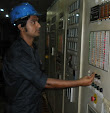Temperature Overload Relay
It is very important to choose an adequate protective device for the safety of the motor during operation and for its durability. The efficiency of protection methods varies according to the application. The overview below will help you to choose. There is no general rule and we are available to advise you for special applications and especially in the case of difficult starting. Overload relays are designed to meet the special protective needs of motor control circuits. Overload relays:
- allow harmless temporary overloads (such as motor starting) without disrupting the circuit
- will trip and open a circuit if current is high enough to cause motor damage over a period of time
- can be reset once the overload is removed
 |
| Temperature overload relay |
 |
| overload relay |
Overload relays are rated by a trip class which defines the length of time it will take for the relay to trip in an overload condition. The most common trip classes are Class 10, Class 20, and Class 30. A Class 10 overload relay, for example, has to trip the motor off line in 10 seconds or less at 600% of the full load amps (which is usually sufficient time for the motor to reach full speed).
Overload Relay in a Motor Circuit
The following illustration shows a motor circuit with a Motor Circuit manual starter and an overload relay.
Current flows through the overload relay while the motor is running. Excess current will cause the overload relay to trip at a predetermined level, opening the circuit between the power source and the motor. After a predetermined amount of time, the overload relay can be reset. When the cause of the overload has been identified and corrected, the motor can be restarted.
 |
| over relay in motor circuit |
Bimetal Overload Relays
Overload protection can be accomplished with the use of a bimetal overload relay. This component consists of a small heater element wired in series with the motor and a bimetal strip that can be used as a trip lever. The bimetal strip is made of two dissimilar metals bonded together. The two metals have different thermal expansion characteristics, so the bimetal strip bends at a given rate when heated. Under normal operating conditions, the heat generated by the heater element will be insufficient to cause the bimetal strip to bend enough to trip the overload relay.
 |
| Temperature overload relay (inside) |
As current rises, heat also rises. The hotter the bimetal strip becomes, the more it bends. In an overload condition, the heat generated from the heater will cause the bimetal strip to bend until the mechanism is tripped, stopping the motor.
Some overload relays equipped with a bimetal strip are designed to reset the circuit automatically when the bimetal strip has cooled and reshaped itself, restarting the motor. If the cause of the overload still exists, the relay will trip again and reset at given intervals. Care must be exercised in the selection of this type of overload relay, since repeated cycling will eventually damage the motor.
Ambient Compensated Bimetal Overload Relay
In certain applications (such as a submersible pump), the motor may be installed in a location having a constant ambient temperature. However, the motor control and overload relay may be installed in a location with a varying ambient temperature. In such cases, the trip point of the overload relay will vary with the temperature of the surrounding air as well as current flowing through the motor, which can lead to premature and nuisance tripping.
 |
| ambient compensated bimetal overload relay |
Ambient compensated bimetal overload relays are designed to overcome this problem. A compensated bimetal strip is used along with a primary bimetal strip. As the ambient temperature changes, both bimetal strips will bend equally and the overload relay will not trip the motor. However, current flow through the motor and the heater element will affect only the primary bimetal strip. In the event of an overload condition, the primary bimetal strip will engage the trip unit.
Electronic Overload Relays
Electronic overload relays are another option for motor protection. The features and benefits of electronic overload relays vary, but there are a few common traits. One advantage offered by electronic overload relays is a heaterless design, reducing installation cost and the need to stock a variety of heaters to match motor ratings. Heaterless design also allows the electronic relay to be insensitive to the ambient temperature, minimizing nuisance tripping.
 |
| Electronic overload relay |
Electronic relays also offer phase loss protection. If a power phase is lost, motor windings can burn out very quickly. Electronic overload relays can detect a phase loss and disconnect the motor from the power source. Phase loss protection is not available on mechanical types of overload relays.








